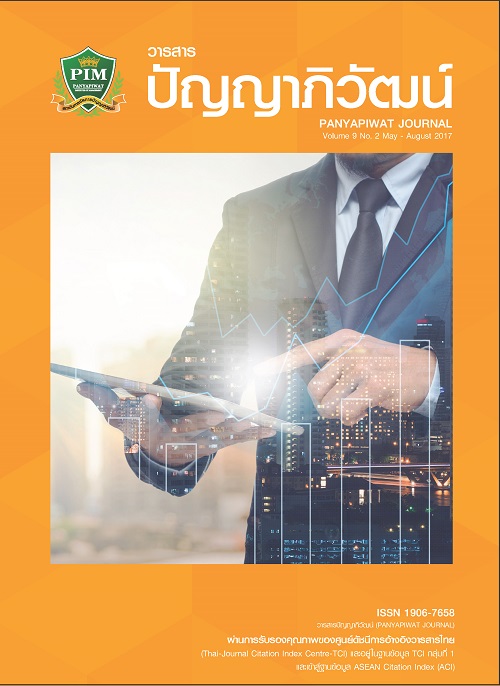ปัจจัยที่มีอิทธิพลเชิงโครงสร้างต่อความตั้งใจซื้อสินค้าในห้างค้าปลีกสมัยใหม่ ในจังหวัดหนองคายของผู้บริโภคชาวลาว
Main Article Content
บทคัดย่อ
การวิจัยในครั้งนี้มีวัตถุประสงค์เพื่อหารูปแบบสมการโครงสร้างของปัจจัยที่มีอิทธิพลต่อความตั้งใจซื้อสินค้าของผู้บริโภคชาวลาวในห้างค้าปลีกในจังหวัดหนองคาย โดยการใช้เทคนิคการวิเคราะห์ข้อมูลด้วยวิธีการ PLS-PM จากการเก็บข้อมูลจำนวน 221 ตัวอย่าง พบว่าสมการโครงสร้างที่วิเคราะห์ได้นั้นไม่ได้อยู่ในรูปแบบสมการที่เป็นเส้นตรง โดยมีปัจจัยกระตุ้น (Moderator) และปัจจัยแทรกซ้อน (Mediator) สมการเดียวกัน นอกจากนั้นแล้วสมการยังมีลักษณะเป็นสมการเชิงวิถีหรือมีตัวแปรตามที่มีบทบาทเป็นตัวแปรอิสระของตัวแปรตามต่อไป ปัจจัยที่นำมาวิเคราะห์ในครั้งนี้เกิดจากการวิเคราะห์องค์ประกอบ 19 ตัวแปร ได้เป็น 6 ปัจจัย และมีปัจจัยส่วนบุคคลเป็นตัวแปรในการวิเคราะห์ครั้งนี้ ปัจจัยที่มีความสำคัญที่สุดในการวิเคราะห์สมการคือ ปัจจัยต้นทุนของลูกค้า และปัจจัยการกระตุ้นทางอารมณ์ เนื่องจากเป็นปัจจัยกระตุ้น และปัจจัยแทรกซ้อนที่ทำงานร่วมกับปัจจัยอื่นๆ อีก 5 ปัจจัย คือ จุดสัมผัสทางกายภาพ (สิ่งที่ผู้บริโภครับรู้ รู้สึก ได้รับ และมีประสบการณ์ อันเกิดจากการซื้อสินค้าและบริการจากห้างค้าปลีก) ปัจจัยความปลอดภัยของชีวิต ปัจจัยวิถีชีวิต ปัจจัยส่วนบุคคลและปัจจัยอื่นๆ
This research aimed to analyze a structural equation model (SEM) of affecting factors on purchasing intention of Lao consumer behavior in a retail department store in Nong Khai Province, Thailand. The analysis used PLS-PM technique and collected 221 samplings. The research has shown that the SEM was not the linear equation. The SEM had moderator and mediation factors influence on intention and formed in path model as well. The factors created from 19 variables into six factors and added personal profile factor in the equation. There are two primary factors in this equation, customer cost, and emotion enhancement because they are moderators and mediation factors work with other five factors, Physical Touch Point, Life Safety, Life Style, Customer Profile, and Other Factor.
Article Details
“ข้าพเจ้าและผู้เขียนร่วม (ถ้ามี) ขอรับรองว่า บทความที่เสนอมานี้ยังไม่เคยได้รับการตีพิมพ์และไม่ได้อยู่ระหว่างกระบวนการพิจารณาลงตีพิมพ์ในวารสารหรือแหล่งเผยแพร่อื่นใด ข้าพเจ้าและผู้เขียนร่วมยอมรับหลักเกณฑ์การพิจารณาต้นฉบับ ทั้งยินยอมให้กองบรรณาธิการมีสิทธิ์พิจารณาและตรวจแก้ต้นฉบับได้ตามที่เห็นสมควร พร้อมนี้ขอมอบลิขสิทธิ์บทความที่ได้รับการตีพิมพ์ให้แก่สถาบันการจัดการปัญญาภิวัฒน์หากมีการฟ้องร้องเรื่องการละเมิดลิขสิทธิ์เกี่ยวกับภาพ กราฟ ข้อความส่วนใดส่วนหนึ่งและ/หรือข้อคิดเห็นที่ปรากฏในบทความข้าพเจ้าและผู้เขียนร่วมยินยอมรับผิดชอบแต่เพียงฝ่ายเดียว”
เอกสารอ้างอิง
Ajzen, I. & Fishbein, M. (1980). Understanding Attitudes and Predicting Social Behavior. Englewood CliVs, NJ: Prentice-Hall.
Ajzen, I. (1991). The Theory of Planned Behavior. Organization Behavior and Human Decision Processes,50(2), 179-211.
Asian Development Bank. (2016). Asian Development Outlook(ADO)2016:Asia’s Potential Growth. Retrieved April 12, 2016, from https://www.adb.org/publications/asian-development-outlook-2016-asia-potential-growth
BĂLĂŞESCU, S. (2014). Contribution to the Foundation of Marketing Mix for Retail Companies. Bulletin of the Transilvania University of Braşov,7(56), 17-24.
Booms, B. H. & Bitner, M. J. (1981). MarketingStrategiesandOrganizationStructuresforServiceFirms.Chicago: Marketing of Services, American Marketing Association.
Borden, N. H. (1964). The Concept of the Marketing Mix.Journal of Advertising Research,2, 2-7.
Brei, V. A., D’Avila, L., Camargo, L. F. & Engels, J. (2011). The Influence of Adaptation and Standardization of the Marketing Mix on Performance: a Meta-Analysis. Brazilian Administration Review, 8(3), 266-287.
Bukenya, J. O., Mukiibi, M. L., Molnar, J. J. & Siaway, A. T. (2007). Consumer Purchasing Behaviors and Attitudes toward Shopping at Public Markets. Journal of Food Distribution Research,38(2), 12-21.
CEL Consulting. (2016). Vientiane Capital’s GDP to grow by 12% till 2015. Retrieved April 12, 2016, from https://www.cel-consulting.com/en/category/market-news/Vientiane-Capital-GDP-to-grow-till-2015
Chin, W. W., Marcolin, B. L. & Newsted, P. R. (1996). A Partial Least Squares Latent Variable Modeling Approach for Measuring Interaction Effects: Results from a Monte Carlo Simalation Study and Voice Mail Emotion/Adoption Study. ProceedingoftheSeventeenthInternationalConferenceonInformationSystems. December 16-18, 1996 Cleveland, Ohio, USA, 21-41.
Cosmides, L. & Tooby, J. (2000). Evolutionary psychology and the emotions. In M. Lewis & J. M. Haviland-Jones (eds.), Hand book of Emotions,2nd Edition. (pp. 91-115.) New York: Guilford.
Department of Tourism. (2016). Tourism Statistic in 2015. Retrieved April 12, 2016, from https://www.tourism.go.th/home/details/11/221/24246 [in Thai]
Fishbein, M. & Ajzen, I. (2010). Predict and Changing Behavior (the Reasoned Action Approach).New York: Psychology Press.
Frank, R. H. (1988). Passions within reason: The strategic role of thee motions.New York: Norton.Fridlund, A. J. (1991). The Sociality of Solitary Smiles: Effects of an Implicit Audience. Journal of Personality and Social Psychology, 60, 229-240.
Iqbal, R., Grzywaczewski, A. & Chang, V. (2016). Human Information Seeking Behaviour and Its Impact on Personalised Information Retrieval: An Advanced Analysis and Literature review. International Journal of Information Management, Available online June 20, 2016.
Kaihatu, T. S. & Spence, M. T. (2016). The Relationship between Shopping Mall Image and Congruity on Customer Behaviour: Evidence from Indonesia. Australasian Marketing Journal(AMJ),24(2), 141-145.
Kittimetheekul, N., Keorodom, B. & Vongsanga, N. (2016). Retail Customer Buying Behavior of Lao People in Vientiane, Lao PDR on Fresh Seafood in Nong Khai Province, Thailand. Rajapark Institute Research Journal, 10(19), 44-54. [in Thai]
Kittimetheekul, N., Vongsanga, N., Lomchanthala, P. & Keorodom, B. (2015). The Perspective of Consumers in Vientiane, Laos PDR. toward the Thai Shopping Mall in the Border Area, Nongkhai Province, Thailand: by Factor Analysis Technique. University of the Thai Chamber of Commerce Journal,35(4), 16-28. [in Thai]
Lancaster, G. & Massingham, L. (2011). Essentials of Marketing Management(1st ed.). New York: Routledge.
McCarthy, J. E. (1964). Basic Marketing. A Managerial Approach. Homewood, IL: Irwin.
Michon, R., Chebat, J. C. & Turley, L. W. (2005). Mall Atmospherics: the Interaction Effects of the Mall Environment on Shopping Behavior. Journal of Business Research, 58, 576-583
Möller, K. (2006). The Marketing Mix Revisited: Towards the 21st Century Marketing by E. Constantinides.
Journal of Marketing Management,22(3), 439-450.
Oatley, K. (2000). The Sentiments and Beliefs of Distributed Cognition. In N. Frijda & A. S. R. Manstead & S. Bem (Eds.). Emotions and Beliefs: How Feelings Influence Thoughts. (pp.78-107). Cambridge: Cambridge University Press.
Pomfret, R. (2013). ASEAN’s New Frontiers: Integrating the Newest Members into the ASEAN Economic Community. Asian Economic Policy Review,8(1), 25-41.
Prasetyo, A. H. & Wei, L. (2016). Towards Strategic Mix 5P. International Journal of Business Management and Economic Research,7(3), 654-661.
Sarkar, A. (2008). Latest Trends in Consumer Buying Behavior in Lifestyle Centers Worldwide. The Icfaian Journal of Management Research,7(6), 70-82.
Scherer, K. R. (2000). Emotion. In M. Hewstone & W. Stroebe (Eds.). Introduction to Social Psychology: A European Perspective (3rd ed., pp. 151-191). Oxford: Blackwell.
Spiggle, S. & Sewall, M. A. (1987). A Choice Sets Model of Retail Selection. Journal of Marketing,51, 97-111.Stevens, J. (2002). Applied Multivariate Statistics for the Social Sciences(4th ed.). Mahwah, NJ: Lawrence Erlbaum Associates.
Vinzi, E. V., Chin, W. W., Henseler, H. J. & Wang H. (2011). Handbook of Partial Least Squares Concept, Method, and Application. New York: Springer.
Wichitnpoparat, P. et al. (2015). Affecting of Laos Consumer Attitude of Product and Service on Export Efficiency of SMEs in Thailand. The Office of SMEs Promotion (OSMEP), Bangkok. [in Thai]


